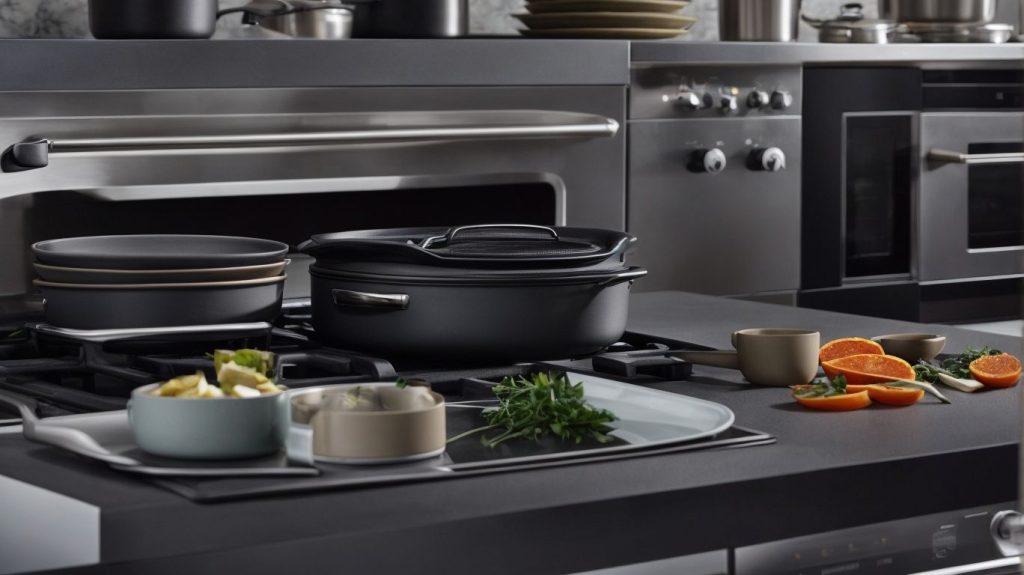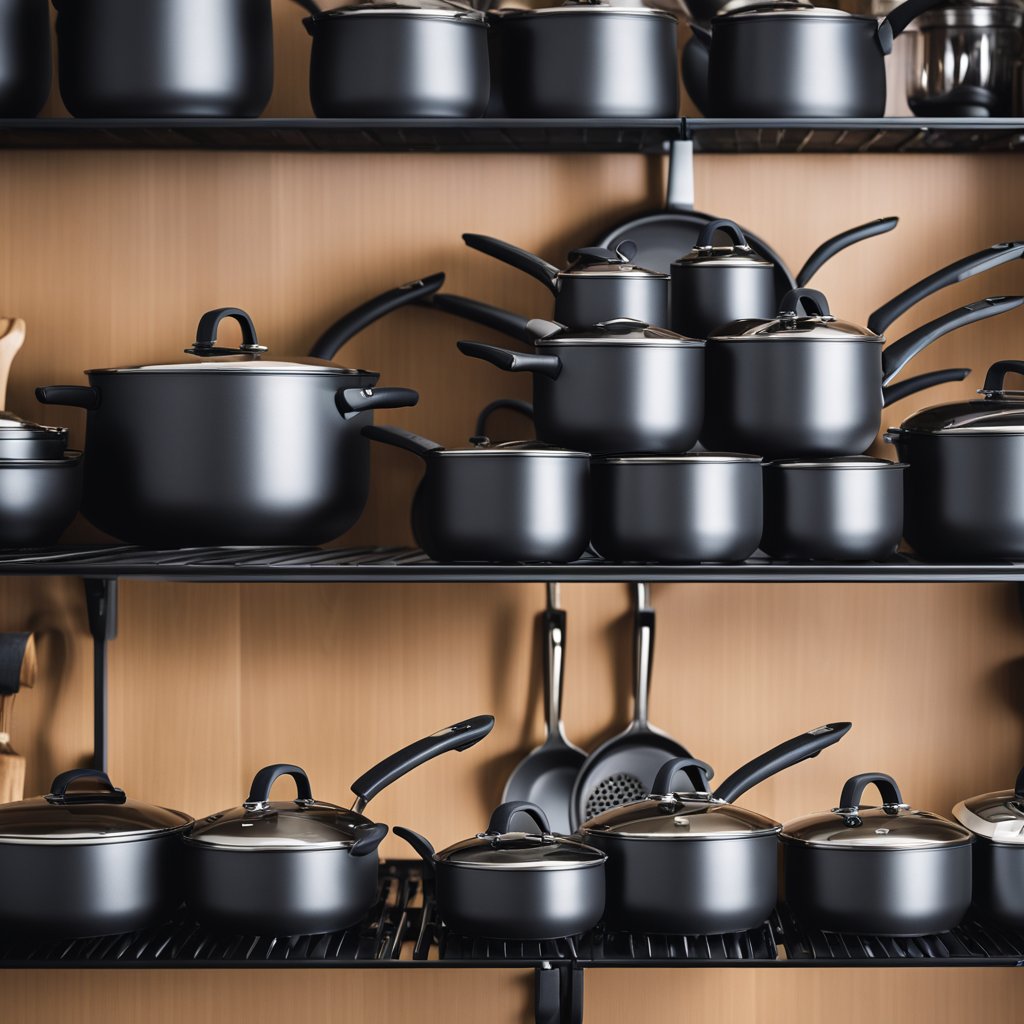This post contains affiliate links. See the affiliate disclaimer here.
In the world of cookware, the choices can be overwhelming. Two popular options that often stand out are hard anodized and ceramic cookware.
These materials have their unique properties and benefits, making them suitable for different cooking needs.
In this article, we will delve into the differences between hard anodized and ceramic cookware, examining their material composition, heat conductivity, durability, and non-stick properties.
We will also explore which type of cookware is better for high and low-heat cooking. We’ll highlight the specific benefits of each type, including the scratch and abrasion resistance of hard anodized cookware and the non-toxic, environmentally friendly properties of ceramic cookware.
By the end of this article, you’ll have a clear understanding of the characteristics of both hard anodized and ceramic cookware, helping you make an informed decision for your cooking needs.

Key Takeaways:
- Hard anodized cookware is made of aluminum that has undergone a special electrochemical process, making it durable and resistant to scratches and abrasions.
- Ceramic cookware is made of clay and water, making it non-toxic and environmentally friendly, with the added benefit of being non-stick without the use of harmful chemicals.
- When it comes to high-heat cooking, hard anodized cookware is the better option due to its excellent heat conductivity, while ceramic cookware is ideal for low-heat cooking and versatility in cooking methods.
What Is Hard Anodized Cookware?
Hard anodized cookware is made from aluminum that has undergone an electrochemical process to harden the surface, resulting in a durable and scratch-resistant material.
This process, known as anodization, involves immersing the aluminum in an acid electrolyte and applying an electric current, which stimulates the formation of a robust oxide layer on the metal’s surface. The hard anodization significantly strengthens the aluminum, making it more resistant to corrosion and wear. This results in cookware with exceptional durability, able to withstand the rigors of everyday cooking.
With the addition of a non-stick coating, hard-anodized cookware becomes an ideal choice for chefs and home cooks alike, offering a reliable, efficient, and safe cooking experience.
What Is Ceramic Cookware?
Ceramic cookware utilizes a non-stick coating derived from natural materials such as sand and clay, providing a safer and environmentally friendly alternative to traditional non-stick cookware.
This non-stick coating is often free from PFOA and PTFE, two chemicals commonly found in traditional non-stick cookware like Teflon, which may release harmful fumes when overheated. The composition of ceramic cookware makes it resistant to high temperatures, reducing the risk of releasing toxic substances.
Renowned brands like GreenPan focus on eco-friendly manufacturing, using innovative technologies to ensure that their ceramic cookware is free from heavy metals and other harmful substances.
Manufacturers carefully apply multiple layers of the ceramic coating to ensure durability and effectiveness. The ceramic particles create a smooth surface that minimizes the need for excess oil, promoting healthier cooking options.
What Are the Differences Between Hard Anodized and Ceramic Cookware?
The distinctions between hard anodized and ceramic cookware encompass differences in material composition, heat conductivity, durability, and non-stick properties, impacting their performance in various cooking scenarios.
Hard anodized cookware, such as the renowned All-Clad range, is made of aluminum that has gone through an electrochemical process, resulting in a hard, smooth surface with excellent heat distribution. This makes it ideal for searing and browning meats, as well as for dishes that require high heat.
On the other hand, ceramic cookware, like the stylish Caraway collection, is constructed with a ceramic-based coating, offering a non-toxic, non-stick surface that is perfect for low-fat cooking and easy cleaning.
Regarding durability, hard anodized cookware proves to be highly resistant to scratches, corrosion, and wear, making it suitable for long-term use.
In contrast, while ceramic cookware is generally resilient, the ceramic coating may be prone to chipping if mishandled. Hard anodized cookware typically excels in conducting heat evenly, while ceramic cookware’s performance in this aspect may vary among different brands and models.
Ultimately, the choice between these two types of cookware depends on individual cooking preferences and the specific dishes being prepared. For high-heat cooking and durability, hard anodized cookware may be the preferred option, while ceramic cookware stands out for its non-stick properties and suitability for low-fat cooking methods.
Material Composition
The material composition of hard anodized and ceramic cookware differs significantly, with hard anodized cookware primarily constructed from aluminum, while ceramic cookware features a coating made from natural materials.
Hard anodized cookware is created through an electrochemical process that transforms the surface of aluminum, making it harder and more durable than conventional aluminum. This process also makes the aluminum non-reactive, offering a safe option for cooking acidic foods. The hard anodized layer provides excellent heat conduction and retention, resulting in even cooking.
On the other hand, ceramic cookware typically utilizes a base of aluminum or other metals, which is then coated with a layer of ceramic, often made from materials like sand and clay. The ceramic coating offers a non-stick surface that is free from synthetic chemicals, providing a natural and eco-friendly option for cooking. This natural coating also imparts a unique flavor to the cooked food.
Heat Conductivity
Heat conductivity varies between hard anodized and ceramic cookware, with hard anodized aluminum providing efficient heat distribution, while ceramic cookware often incorporates stainless steel for heat retention and even cooking.
Regarding hard anodized cookware, the aluminum base plays a crucial role in distributing heat evenly, ensuring that all parts of the cookware receive the same amount of heat, leading to uniform cooking results. This property is especially beneficial for dishes that require precise temperature control, such as sauces and delicate proteins.
On the other hand, ceramic cookware is typically designed with a layer of stainless steel underneath the ceramic coating, allowing for superior heat retention. This facilitates even cooking, maintaining the desired temperature throughout the cooking process.
Durability
In terms of durability, hard anodized cookware exhibits exceptional scratch and abrasion resistance, while ceramic cookware is known for its non-reactivity to acidic foods and absence of PFOAs, contributing to its robustness.
Hard anodized cookware gains its robustness through a process of electrochemical hardening, creating a surface that is highly resistant to scratching and wear, making it ideal for daily cooking activities. This durable coating also ensures that the cookware retains its performance over time, providing long-lasting value to the user.
On the other hand, ceramic cookware is lauded for its non-reactivity to acidic foods, which prevents the leaching of harmful chemicals into the food. In addition, the absence of PFOAs, lead, and cadmium further enhances its durability and safety, making it a popular choice among health-conscious individuals.
Non-stick Properties
The non-stick properties of hard anodized and ceramic cookware stem from their respective coatings, offering convenient cooking experiences and requiring minimal oil or fats, while ceramic cookware also accommodates the use of silicone utensils without compromising its non-stick nature.
In hard anodized cookware, the aluminum undergoes a process that creates a hard, non-porous surface, ensuring effective non-stick properties and durability. This makes it suitable for high-heat cooking and prevents food from sticking, making cleaning a breeze.
On the other hand, ceramic cookware is infused with a non-stick coating, often made from minerals like silicon and oxygen, providing a smooth cooking surface.
Regarding convenience, both types of cookware offer remarkable performance. America’s Test Kitchen has also praised the non-stick attributes of hard anodized and ceramic cookware for their ability to cook various dishes with little to no oil, showcasing their practicality and health-conscious benefits.
Which One Is Better for Cooking?
The suitability of hard anodized or ceramic cookware for cooking depends on the specific requirements of high heat and low heat cooking techniques, with each type offering distinct advantages in different culinary scenarios.
Hard anodized cookware, such as Calphalon, is known for its superior heat conductivity and durability, making it ideal for high heat cooking methods like searing and browning. The non-stick properties of hard anodized pans also make them suitable for low heat cooking, allowing for easy food release and quick cleanup.
On the other hand, ceramic cookware from brands like GreenPan is celebrated for its non-toxic, environmentally friendly nature.
It is perfect for low heat cooking, as it distributes heat evenly, preventing hotspots and scorched food. It may not withstand the high temperatures required for certain high heat cooking techniques, risking damage to the ceramic coating.
For High Heat Cooking
Regarding high heat cooking, hard anodized cookware excels in providing even heat distribution and durability, while ceramic cookware offers a non-toxic and environmentally friendly option, catering to diverse cooking preferences.
Hard anodized cookware, typically made from aluminum that has undergone an electrochemical process, boasts exceptional heat conductivity and durability.
This makes it a popular choice for professional chefs and home cooks who require cookware that can withstand high temperatures without warping or deteriorating over time. The non-reactive nature of the hard anodized surface ensures that it does not impart any unwanted flavors to the food being prepared.
On the other hand, ceramic cookware provides a natural, non-toxic alternative to traditional non-stick coatings like Teflon, which may contain PFOAs – potentially harmful chemicals. Its smooth and glossy surface not only facilitates easy food release and cleaning but also eliminates the risk of toxic fumes being released when exposed to high heat.
For Low Heat Cooking
In the realm of low heat cooking, ceramic cookware’s non-stick properties without harmful chemicals make it an ideal choice, while hard anodized cookware’s durability and scratch resistance also contribute to its effectiveness in low heat culinary preparations.
For those seeking non-stick capabilities along with easy cleanup, ceramic cookware offers an appealing solution. Its natural non-stick properties eliminate the need for excessive oils or fats, facilitating healthier cooking. Ceramic cookware is often free from PTFE and PFOA, harmful chemicals commonly found in traditional non-stick coatings, ensuring that no toxins leach into the food during the cooking process.
On the other hand, hard anodized cookware presents remarkable durability and resistance to scratches, making it an ideal choice for low heat cooking techniques. Its robust construction allows for the use of metal utensils without the fear of damaging the cooking surface, offering convenience and longevity in the kitchen.
What Are the Benefits of Hard Anodized Cookware?
Hard anodized cookware offers numerous benefits, including exceptional scratch and abrasion resistance, as well as even heat distribution, enhancing its appeal for professional and home cooks alike.
Calphalon, a leading brand in hard anodized cookware, is known for its durable and resilient manufacturing. This type of cookware not only withstands the rigors of metal utensils but also resists scratches from abrasive cleaning tools, maintaining its sleek appearance over time.
The even heat distribution of hard anodized cookware sets it apart, allowing for consistent cooking results and preventing hot spots that can lead to unevenly cooked dishes. This quality makes it ideal for searing, browning, and sautéing, providing the precision and control that professional chefs and home cooks appreciate.
The versatility of hard anodized cookware makes it suitable for a wide range of cooking needs. Whether you’re preparing delicate sauces or simmering hearty stews, this cookware delivers reliable performance, adapting seamlessly to different culinary techniques.
Scratch and Abrasion Resistant
The scratch and abrasion resistance of hard anodized cookware stems from its hardened aluminum surface, ensuring longevity and durability in the face of everyday cooking demands, making it an ideal choice for busy kitchens.
When subjected to the hard anodization process, the aluminum undergoes an electrolytic passivation, forming a thick layer of oxide on the surface that is both non-toxic and incredibly resistant to scratching and abrasion. This creates a protective barrier, making the cookware less prone to damage from metal utensils and allowing for prolonged use without deterioration in quality.
One of the most notable impacts of this enhanced scratch and abrasion resistance is the extended lifespan of the cookware, proving to be a valuable investment for individuals seeking long-term durability in their kitchen essentials. Brands renowned for their hard anodized cookware, such as GreenPan, have capitalized on the benefits of this process, offering consumers a reliable and sustainable option for their cooking needs.
Non-reactive to Acidic Foods
The non-reactive nature of hard anodized cookware to acidic foods, without the presence of PFOAs, ensures that it preserves the flavors and integrity of delicate ingredients, making it a reliable choice for a wide range of culinary creations.
Hard anodized cookware, such as the renowned Zwilling Spirit collection, offers a durable, scratch-resistant surface that is highly resistant to corrosion and wear. This makes it ideal for cooking acidic dishes, as it won’t react with the food or alter its taste. The non-stick coating on some hard anodized cookware further enhances its non-reactive properties, ensuring that even sticky or delicate foods can be cooked without the risk of flavor contamination or unhealthy chemical exposure, offering a safer and more enjoyable cooking experience.
Even Heat Distribution
The even heat distribution offered by hard anodized cookware, often complemented by stainless steel components, ensures consistent cooking results and eliminates hot spots, providing a reliable cooking experience for discerning chefs.
Legend Cookware, renowned for its innovative designs, incorporates hard anodized aluminum, known for its durability and ability to withstand high cooking temperatures. When combined with stainless steel, this cookware achieves superior heat retention, contributing to enhanced cooking precision.
America’s Test Kitchen has repeatedly praised the even heat distribution of hard anodized cookware, attributing it to the excellent performance in searing, browning, and simmering. This ensures that food is cooked evenly and thoroughly, enhancing the flavors and textures of the dishes.
What Are the Benefits of Ceramic Cookware?
Ceramic cookware offers compelling benefits such as non-toxic and environmentally friendly attributes, alongside its impressive versatility in various cooking applications, catering to health-conscious and creative cooks.
One of the most noteworthy advantages of ceramic cookware is its non-toxic nature, as it does not leach harmful chemicals or metals into food, making it a safe and healthy option for cooking. Its eco-friendly composition makes it an attractive choice for individuals seeking sustainable kitchenware. Its adaptability allows it to be used on stovetops, in ovens, and even in the freezer, providing convenience and flexibility in culinary preparation. When considering purchasing ceramic cookware, it is essential to pair it with silicone utensils to maintain its longevity and preserve its non-stick properties.
Non-toxic and Environmentally Friendly
Ceramic cookware’s non-toxic and environmentally friendly characteristics, coupled with the absence of Teflon, contribute to a safe and sustainable cooking experience, aligning with the preferences of health-conscious and environmentally aware individuals.
When considering the safety aspect, it’s important to highlight that ceramic cookware is free from harmful chemicals and heavy metals, providing peace of mind for users concerned about potential leaching into their food. The manufacturing process of ceramic cookware often aligns with environmentally friendly practices, utilizing sustainable materials and production methods.
Brands like Caraway and All-Clad offer ceramic cookware options that not only prioritize safety and sustainability but also excel in terms of durability and cooking performance. This ensures that consumers can enjoy the benefits of non-toxic cookware without compromising on functionality or quality.
Non-stick Properties without Harmful Chemicals
Ceramic cookware’s non-stick properties without the presence of harmful chemicals, such as PFOAs, offer a healthy and convenient cooking surface, enhancing the appeal of ceramic cookware for health-conscious individuals and families.
The use of innovative materials, such as the Thermolon coating utilized in GreenPan cookware, sets it apart as an excellent choice for those seeking an alternative to traditional non-stick options. The absence of toxic substances in ceramic cookware, championed by renowned chef and consumer advocate Lisa McManus, has resulted in increased demand for these products, with consumers prioritizing their health and well-being. In addition, the easy cleaning and durability of ceramic cookware make it a practical and sustainable choice for any modern kitchen.
Versatility in Cooking
Ceramic cookware’s versatility in cooking extends to its compatibility with high heat applications, offering a broad spectrum of culinary possibilities while providing a safe and efficient cooking platform for diverse recipes and techniques.
Whether it’s searing meats at high temperatures, simmering delicate sauces, or slowly braising vegetables, ceramic cookware such as Calphalon and Zwilling Spirit proves to be an invaluable asset in the kitchen. Its non-reactive nature ensures that it doesn’t alter the flavor of the ingredients, making it ideal for preparing a variety of dishes. The even heat distribution and retention properties of ceramic cookware contribute to consistent cooking results, giving home chefs the confidence to explore different cooking styles and cuisines.

